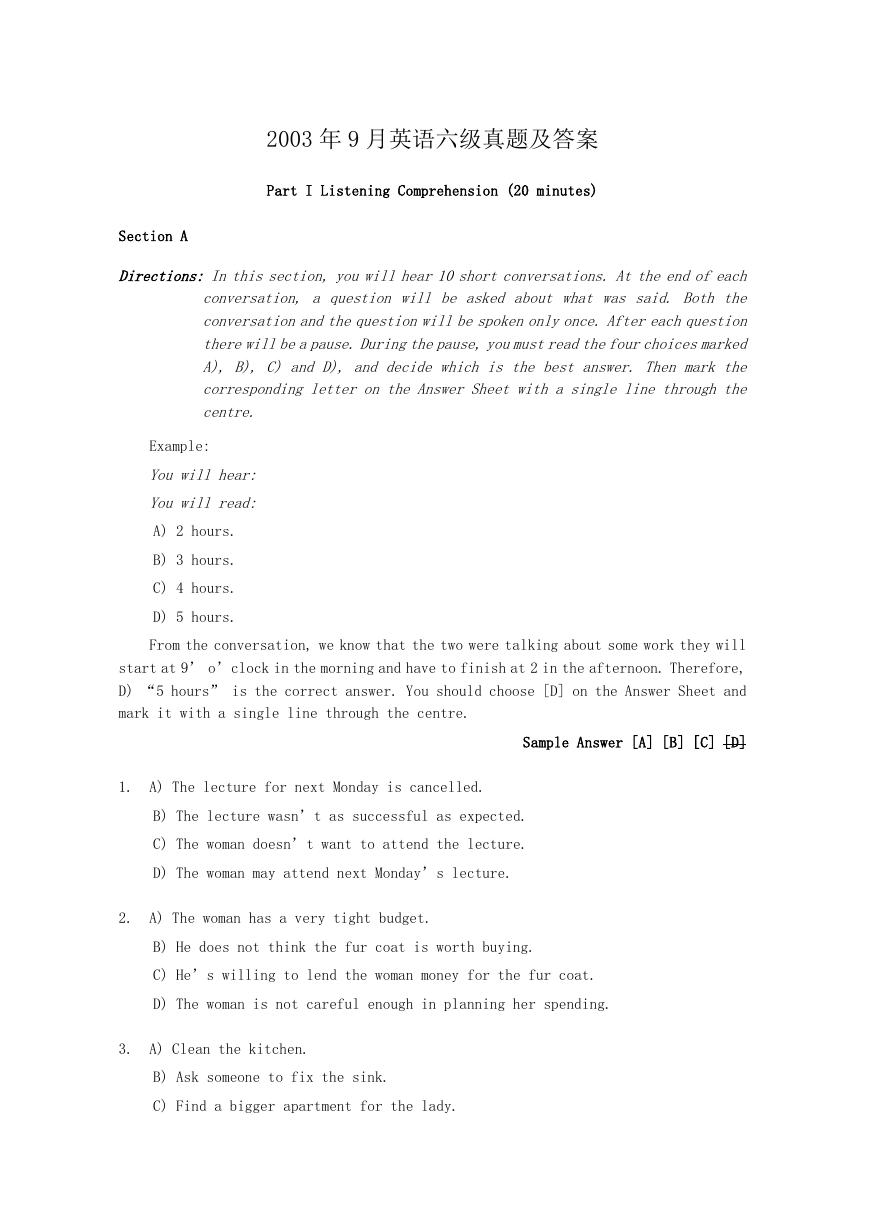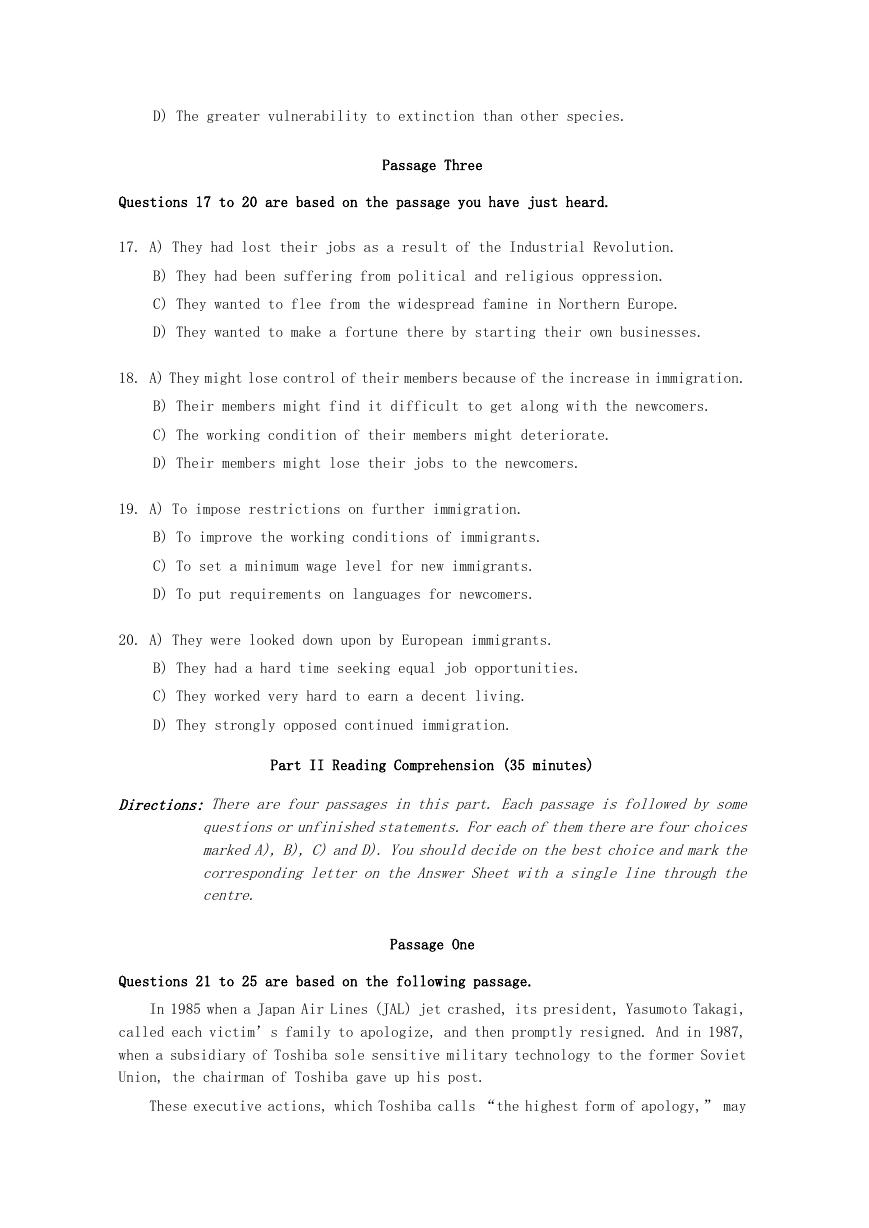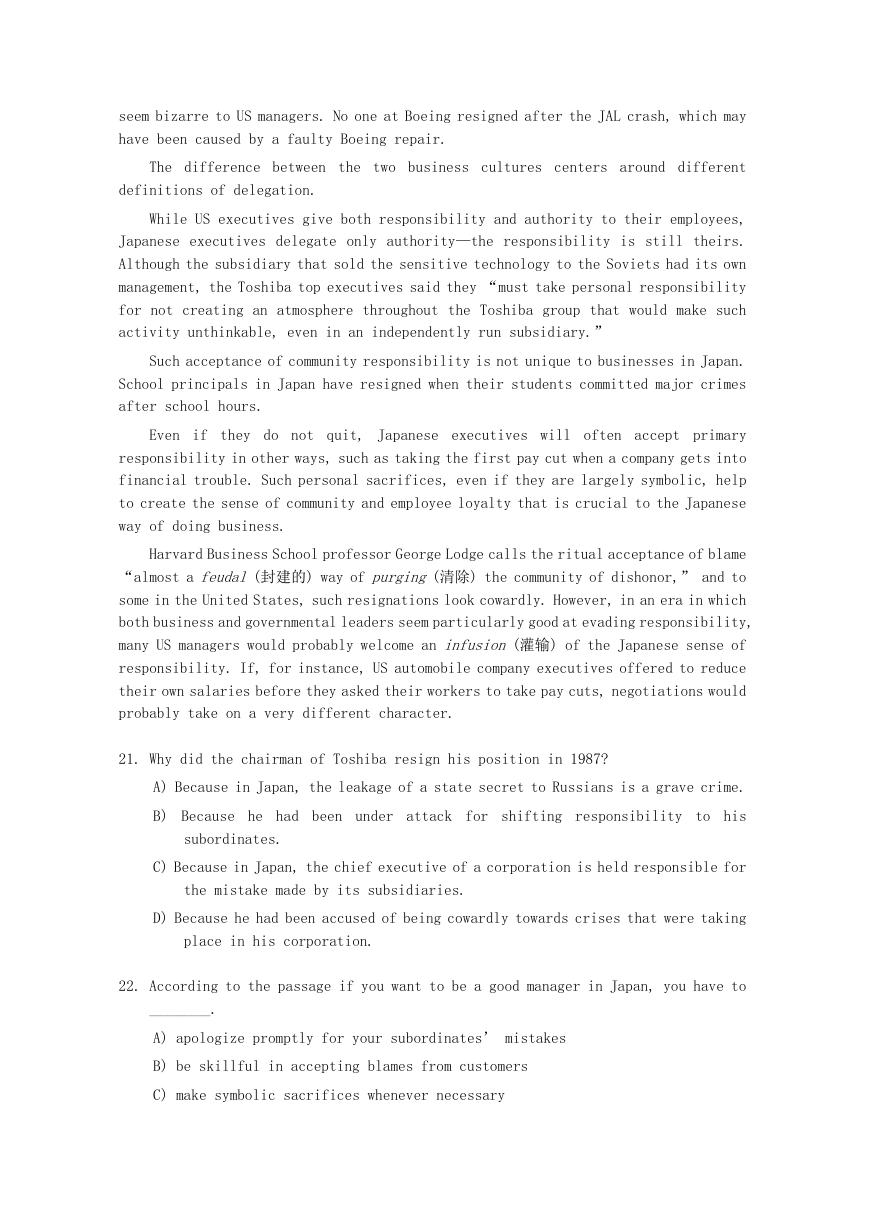2003 年 9 月英语六级真题及答案
Part I Listening Comprehension (20 minutes)
Section A
Directions: Inthissection,youwillhear10shortconversations.Attheendofeach
conversation, a question will be asked about what was said. Both the
conversationandthequestionwillbespokenonlyonce.Aftereachquestion
therewillbeapause.Duringthepause,youmustreadthefourchoicesmarked
A), B), C) and D), and decide which is the best answer. Then mark the
corresponding letter on the Answer Sheet with a single line through the
centre.
Example:
You will hear:
You will read:
A) 2 hours.
B) 3 hours.
C) 4 hours.
D) 5 hours.
From the conversation, we know that the two were talking about some work they will
start at 9’ o’clock in the morning and have to finish at 2 in the afternoon. Therefore,
D) “5 hours” is the correct answer. You should choose [D] on the Answer Sheet and
mark it with a single line through the centre.
Sample Answer [A] [B] [C] [D]
1.
A) The lecture for next Monday is cancelled.
B) The lecture wasn’t as successful as expected.
C) The woman doesn’t want to attend the lecture.
D) The woman may attend next Monday’s lecture.
2.
A) The woman has a very tight budget.
B) He does not think the fur coat is worth buying.
C) He’s willing to lend the woman money for the fur coat.
D) The woman is not careful enough in planning her spending.
3.
A) Clean the kitchen.
B) Ask someone to fix the sink.
C) Find a bigger apartment for the lady.
�
D) Check the work done by the maintenance man.
4.
A) The lens.
B) The price.
C) The flash.
D) The leather case.
5.
A) She needs another haircut soon.
B) She thinks it worthwhile to try Sadermale’s.
C) She knows a less expensive place for a haircut.
D) She would like to make an appointment for the man.
6.
A) The woman doesn’t want to cook a meal.
B) The woman wants to have a picnic.
C) The woman has a poor memory.
D) The woman likes Mexican food.
7.
A) Everyone enjoyed himself at John’s panics.
B) The woman didn’t enjoy John’s parties at all.
C) It will be the first time for the man to attend John’s party.
D) The woman is glad to be invited to John’s house-warming party.
8.
A) She lacks confidence in herself.
B) She is not interested in computer programming.
C) She has never signed up for any competition before.
D) She is sure to win the programming contest.
9.
A) The man has an enormous amount of work to do.
B) The man has made plans for his vacation.
C) The man will take work with him on his vacation.
D) Work stacked up during the man’s last vacation.
10. A) She likes the job of feeding fish.
B) She finds her new job interesting.
C) She feels unfit for her new job.
D) She’s not in good health.
Section B
Directions: Inthissection,youwillhear3shortpassages.Attheendofeachpassage,
�
you will hear some questions. Both the passage and the questions will be
spokenonlyonce.Afteryouhearaquestion,youmustchoosethebestanswer
fromthefourchoicesmarkedA),B),C)andD).Thenmarkthecorresponding
letter on the Answer Sheet with a single line through the centre.
Questions 11 to 13 are based on the passage you have just heard.
Passage One
11. A) Rally support for their movement.
B) Liberate women from tedious housework.
C) Claim their rights to equal job opportunities.
D) Express their anger against sex discrimination.
12. A) It will bring a lot of trouble to the local people.
B) It is a popular form of art.
C) It will spoil the natural beauty of their surroundings.
D) It is popular among rock stars.
13. A) To show that mindless graffiti can provoke violence.
B) To show that Londoners have a special liking for graffiti.
C) To show that graffiti, in some cases, can constitute a crime.
D) To show that graffiti can make the environment more colorful.
Questions 14 to 16 are based on the passage you have just heard.
Passage Two
14. A) The Asian elephant is easier to tame.
B) The Asian elephant’s skin is more valuable.
C) The Asian elephant is less popular with tourists.
D) The Asian elephant produces ivory of a better quality.
15. A) From the captured or tamed elephants.
B) From the British wildlife protection group.
C) From elephant hunters in Thailand and Burma.
D) From tourists visiting the Thai-Burmese border.
16. A) Their taming for circuses and zoos.
B) The destruction of their natural homes.
C) Man’s lack of knowledge about their behavior.
�
D) The greater vulnerability to extinction than other species.
Questions 17 to 20 are based on the passage you have just heard.
Passage Three
17. A) They had lost their jobs as a result of the Industrial Revolution.
B) They had been suffering from political and religious oppression.
C) They wanted to flee from the widespread famine in Northern Europe.
D) They wanted to make a fortune there by starting their own businesses.
18. A) They might lose control of their members because of the increase in immigration.
B) Their members might find it difficult to get along with the newcomers.
C) The working condition of their members might deteriorate.
D) Their members might lose their jobs to the newcomers.
19. A) To impose restrictions on further immigration.
B) To improve the working conditions of immigrants.
C) To set a minimum wage level for new immigrants.
D) To put requirements on languages for newcomers.
20. A) They were looked down upon by European immigrants.
B) They had a hard time seeking equal job opportunities.
C) They worked very hard to earn a decent living.
D) They strongly opposed continued immigration.
Part II Reading Comprehension (35 minutes)
Directions: There are four passages in this part. Each passage is followed by some
questionsorunfinishedstatements.Foreachofthemtherearefourchoices
markedA),B),C)andD).Youshoulddecideonthebestchoiceandmarkthe
corresponding letter on the Answer Sheet with a single line through the
centre.
Passage One
Questions 21 to 25 are based on the following passage.
In 1985 when a Japan Air Lines (JAL) jet crashed, its president, Yasumoto Takagi,
called each victim’s family to apologize, and then promptly resigned. And in 1987,
when a subsidiary of Toshiba sole sensitive military technology to the former Soviet
Union, the chairman of Toshiba gave up his post.
These executive actions, which Toshiba calls “the highest form of apology,” may
�
seem bizarre to US managers. No one at Boeing resigned after the JAL crash, which may
have been caused by a faulty Boeing repair.
The difference between the two business cultures centers around different
definitions of delegation.
While US executives give both responsibility and authority to their employees,
Japanese executives delegate only authority—the responsibility is still theirs.
Although the subsidiary that sold the sensitive technology to the Soviets had its own
management, the Toshiba top executives said they “must take personal responsibility
for not creating an atmosphere throughout the Toshiba group that would make such
activity unthinkable, even in an independently run subsidiary.”
Such acceptance of community responsibility is not unique to businesses in Japan.
School principals in Japan have resigned when their students committed major crimes
after school hours.
Even if they do not quit, Japanese executives will often accept primary
responsibility in other ways, such as taking the first pay cut when a company gets into
financial trouble. Such personal sacrifices, even if they are largely symbolic, help
to create the sense of community and employee loyalty that is crucial to the Japanese
way of doing business.
Harvard Business School professor George Lodge calls the ritual acceptance of blame
“almost a feudal (封建的) way of purging (清除) the community of dishonor,” and to
some in the United States, such resignations look cowardly. However, in an era in which
both business and governmental leaders seem particularly good at evading responsibility,
many US managers would probably welcome an infusion (灌输) of the Japanese sense of
responsibility. If, for instance, US automobile company executives offered to reduce
their own salaries before they asked their workers to take pay cuts, negotiations would
probably take on a very different character.
21. Why did the chairman of Toshiba resign his position in 1987?
A) Because in Japan, the leakage of a state secret to Russians is a grave crime.
B) Because he had been under attack for shifting responsibility to his
subordinates.
C) Because in Japan, the chief executive of a corporation is held responsible for
the mistake made by its subsidiaries.
D) Because he had been accused of being cowardly towards crises that were taking
place in his corporation.
22. According to the passage if you want to be a good manager in Japan, you have to
________.
A) apologize promptly for your subordinates’ mistakes
B) be skillful in accepting blames from customers
C) make symbolic sacrifices whenever necessary
�
D) create a strong sense of company loyalty
23. What’s Professor George Lodge’s attitude towards the resignations of Japanese
corporate leaders?
A) Sympathetic.
B) Biased.
C) Critical.
D) Approving.
24. Which of the following statements is TRUE?
A) Boeing had nothing to do with the JAL air crash in 1985.
B) American executives consider authority and responsibility inseparable.
C) School principals bear legal responsibility for students’ crimes.
D) Persuading employees to take pay cuts doesn’t help solve corporate crises.
25. The passage is mainly about ________.
A) resignation as an effective way of dealing with business crises
B) the importance of delegating responsibility to employees
C) ways of evading responsibility in times of crises
D) the difference between two business cultures
Passage Two
Questions 26 to 30 are based on the following passage.
As machines go, the car is not terribly noisy, nor terribly polluting, nor terribly
dangerous; and on all those dimensions it has become better as the century has grown
older. The main problem is its prevalence, and the social costs that ensue from the
use by everyone of something that would be fairly harmless if, say, only the rich were
to use it. It is a price we pay for equality.
Before becoming too gloomy, it is worth recalling why the car has been arguably
the most successful and popular product of the whole of the past 100 years—and remains
so. The story begins with the environmental improvement it brought in the 1900s. In
New York city in 1900, according to the Car Culture, a 1975 book by J. Flink, a historian,
horses deposited 2.5 million pounds of manure (粪) and 60,000 gallons of urine (尿)
every day. Every year, the city authorities had to remove an average of 15,000 dead
horses from the streets, it made cars smell of roses.
Cars were also wonderfully flexible. The main earlier solution to horse pollution
and traffic jams was the electric trolley bus(电车). But that required fixed overhead
wires, and rails and platforms, which were expensive, ugly, and inflexible. The car
could go from any A to any B, and allowed towns to develop in all directions with
low-density housing, rather than just being concentrated along the trolley or rail lines.
�
Rural areas benefited too, for they became less remote.
became
a
concern
1950s,
pollution
However, since
have
predicted—wrongly—that the car boom was about to end. In his book Mr. Flink argued
that by 1973 the American market had become saturated, at one car for every 2.25 people,
and so had the markets of Japan and Western Europe (because of land shortages).
Environmental worries and diminishing oil reserves would prohibit mass car use anywhere
else.
in
the
experts
He was wrong. Between 1970 and 1990, whereas America’s population grew by 23%,
the number of cars on its roads grew by 60%. There is now one car for every 1.7 people
there, one for every 2.1 in Japan, one for every 5.3 in Britain. Around 550 million
cars are already on the roads, not to mention all the trucks and mocorcyeles, and about
50 million new ones are made each year worldwide. Will it go on? Undoubtedly, because
people want it to.
26. As is given in the first paragraph, the reason why the car has become a problem
is that ________.
A) poor people can’t afford it
B) it is too expensive to maintain
C) too many people are using it
D) it causes too many road accidents
27. According to the passage, the car started to gain popularity because ________.
A) it didn’t break down as easily as a horse
B) it had a comparatively pleasant odor
C) it caused less pollution than horses
D) it brightened up the gloomy streets
28. What impact did the use of cars have on society?
A) People were compelled to leave downtown areas.
B) People were able to live in less crowded suburban areas.
C) Business along trolley and rail lines slackened.
D) City streets were free of ugly overhead wires.
29. Mr. Flink argued in his book that cars would not be widely used in other countries
because ________.
A) the once booming car market has become saturated
B) traffic jams in those countries are getting more and more serious
C) expensive motorways are not available in less developed countries
D) people worry about pollution and the diminishing oil resources
�
30. What’s wrong with Mr. Flink’s prediction?
A) The use of automobiles has kept increasing worldwide.
B) New generations of cars are virtually pollution free.
C) The population of America has not increased as fast.
D) People’s environmental concerns are constantly increasing.
Passage Three
Questions 31 to 35 are based on the following passage.
Crying is hardly an activity encouraged by society. Tears, be they of sorrow, anger,
or joy, typically make Americans feel uncomfortable and embarrassed. The shedder of
tears is likely to apologize, even when a devastating (毁灭性的) tragedy was the
provocation. The observer of tears is likely to do everything possible to put an end
to the emotional outpouring. But judging from recent studies of crying behavior, links
between illness and crying and the chemical composition of tears, both those responses
to tears are often inappropriate and may even be counterproductive.
Humans are the only animals definitely known to shed emotional tears. Since
evolution has given rise to few, if any, purposeless physiological responses, it is
logical to assume that crying has one or more functions that enhance survival.
Although some observers have suggested that crying is a way to elicit assistance
from others (as a crying baby might from its mother), the shedding of tears is hardly
necessary to get help. Vocal cries would have been quite enough, more likely than tears
to gain attention. So, it appears, there must be something special about tears
themselves.
Indeed, the new studies suggest that emotional tears may play a direct role in
alleviating stress. University of Minnesota researchers who are studying the chemical
composition of tears have recently isolated two important chemicals from emotional
tears. Both chemicals are found only in tears that are shed in response to emotion.
Tears shed because of exposure to cut onion would contain no such substance.
Researchers at several other institutions are investigating the usefulness of tears
as a means of diagnosing human ills and monitoring drugs.
At Tulane University’s Teat Analysis Laboratory Dr. Peter Kastl and his colleagues
report that they can use tears to detect drug abuse and exposure to medication (药
物), to determine whether a contact lens fits properly of why it may be uncomfortable,
to study the causes of “dry eye” syndrome and the effects of eye surgery, and perhaps
even to measure exposure to environmental pollutants.
At Columbia University Dr. Liasy Faris and colleagues are studying tears for clues
to the diagnosis of diseases away from the eyes. Tears can be obtained painlessly without
invading the body and only tiny amounts are needed to perform highly refined analyses.
31. It is known from the first paragraph that ________.
A) shedding tears gives unpleasant feelings to American
�
















 2023年江西萍乡中考道德与法治真题及答案.doc
2023年江西萍乡中考道德与法治真题及答案.doc 2012年重庆南川中考生物真题及答案.doc
2012年重庆南川中考生物真题及答案.doc 2013年江西师范大学地理学综合及文艺理论基础考研真题.doc
2013年江西师范大学地理学综合及文艺理论基础考研真题.doc 2020年四川甘孜小升初语文真题及答案I卷.doc
2020年四川甘孜小升初语文真题及答案I卷.doc 2020年注册岩土工程师专业基础考试真题及答案.doc
2020年注册岩土工程师专业基础考试真题及答案.doc 2023-2024学年福建省厦门市九年级上学期数学月考试题及答案.doc
2023-2024学年福建省厦门市九年级上学期数学月考试题及答案.doc 2021-2022学年辽宁省沈阳市大东区九年级上学期语文期末试题及答案.doc
2021-2022学年辽宁省沈阳市大东区九年级上学期语文期末试题及答案.doc 2022-2023学年北京东城区初三第一学期物理期末试卷及答案.doc
2022-2023学年北京东城区初三第一学期物理期末试卷及答案.doc 2018上半年江西教师资格初中地理学科知识与教学能力真题及答案.doc
2018上半年江西教师资格初中地理学科知识与教学能力真题及答案.doc 2012年河北国家公务员申论考试真题及答案-省级.doc
2012年河北国家公务员申论考试真题及答案-省级.doc 2020-2021学年江苏省扬州市江都区邵樊片九年级上学期数学第一次质量检测试题及答案.doc
2020-2021学年江苏省扬州市江都区邵樊片九年级上学期数学第一次质量检测试题及答案.doc 2022下半年黑龙江教师资格证中学综合素质真题及答案.doc
2022下半年黑龙江教师资格证中学综合素质真题及答案.doc